Starter -- Inspection |
| 1. INSPECT STARTER ASSEMBLY |
- NOTICE:
- These tests must be performed within 3 to 5 seconds to avoid burning out the coil.
Perform a pull-in test.
Remove the nut and disconnect the lead wire from terminal C.
Connect the battery to the magnet starter switch as shown in the illustration. Check that the clutch pinion gear extends.
If the clutch pinion gear does not move, replace the magnet starter switch assembly.
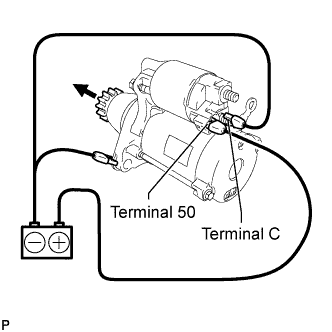
Perform a hold-in test.
Maintain the battery connections of the pull-in test above, but disconnect the negative (-) lead from terminal C. Check that the pinion gear remains extended.
If the clutch pinion gear returns inward, replace the magnet starter switch assembly.
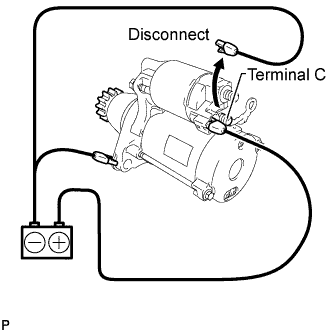 |
Check the clutch pinion gear returns.
Disconnect the negative (-) lead from the starter body. Check that the clutch pinion gear returns.
If the clutch pinion gear does not return, replace the magnet starter switch assembly.
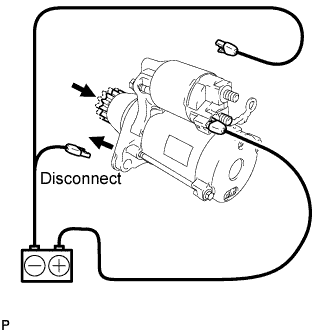 |
Perform a no-load performance test.
Connect the lead wire to terminal C with the nut. Make sure that the lead is not grounded.
- Torque:
- 10 N*m{102 kgf*cm, 7 ft.*lbf}
Clamp the starter in a vise.
- NOTICE:
- Ensure that the starter is secured firmly in the vise to prevent it from falling out.
Connect the battery and an ammeter to the starter as shown in the illustration.
- NOTICE:
- Do not allow any lead to get caught as the pinion gear operates.
Check that the starter operates smoothly and steadily while the pinion gear is moving out. Then measure the current.
- Standard current:
- 90 A or less at 11.5 V
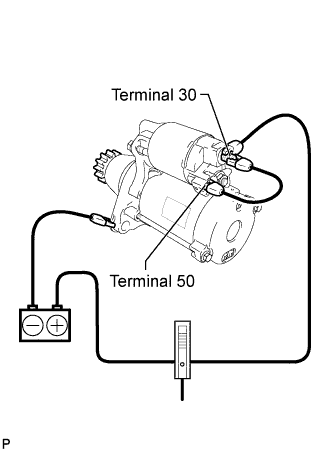 |
| 2. INSPECT STARTER CLUTCH |
Check the starter clutch.
Rotate the clutch pinion gear counterclockwise and check that it turns freely. Try to rotate the clutch pinion gear clockwise and check that it locks.
If necessary, replace the repair service starter kit.
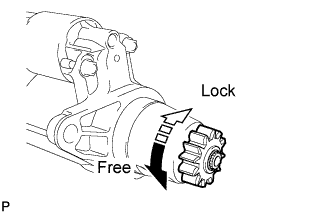 |
| 3. INSPECT MAGNET STARER SWITCH ASSEMBLY |
Inspect the plunger for an open circuit.
Push in the plunger and check that it returns quickly to its original position.
If necessary, replace the magnet starter switch assembly.
 |
Inspect the pull-in coil for an open circuit.
Measure the resistance according to the value(s) in the table below.
- Standard Resistance:
Tester Connection Condition Specified Condition Terminal 50 - Terminal C Always Below 1 Ω
 |
Inspect the hold-in coil.
Measure the resistance according to the value(s) in the table below.
- Standard Resistance:
Tester Connection Condition Specified Condition Terminal 50 - Switch body Always Below 2 Ω
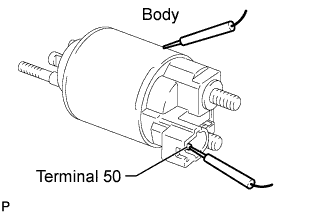 |
| 4. INSPECT STARTER ARMATURE ASSEMBLY |
- HINT:
- If these is no continuity between any segments, replace the starter armature assembly.
Check the surface of the commutator for dirt and burns.
If the surface is dirty or burnt, correct it with sandpaper (No. 400) or a lathe.
Inspect the commutator for an open circuit.
Measure the resistance according to the value(s) in the table below.
- Standard Resistance:
Tester Connection Condition Specified Condition Segment - Segment Always Below 1 Ω
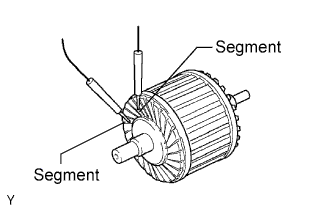
Inspect the commutator for a short circuit.
Measure the resistance according to the value(s) in the table below.
- Standard Resistance:
Tester Connection Condition Specified Condition Commutator - Armature coil core Always 10 kΩ or higher
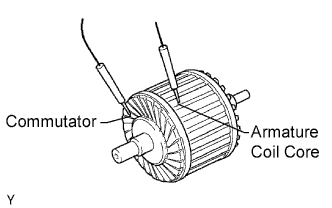
Using a vernier caliper, measure the commutator length.
- Standard length:
- 3.1 to 3.8 mm (0.122 to 0.149 in.)
- Maximum length:
- 3.8 mm (0.149 in.)
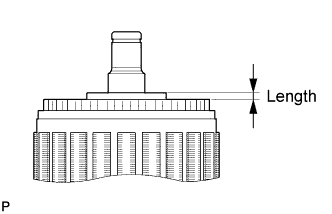 |
| 5. INSPECT STARTER COMMUTATOR END FRAME ASSEMBLY |
Using a vernier caliper, measure the brush length.
- Standard length:
- 4.0 to 9.0 mm (0.158 to 0.354 in.)
- Minimum length:
- 4.0 mm (0.158 in.)
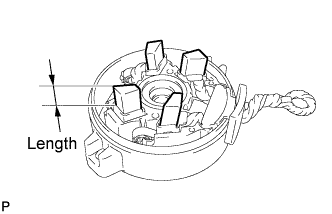 |
Inspect the insulation.
Measure the resistance according to the value(s) in the table below.
- Standard Resistance:
Tester Connection Condition Specified Condition Positive (+) brush - Negative (-) brush Always 10 kΩ or higher
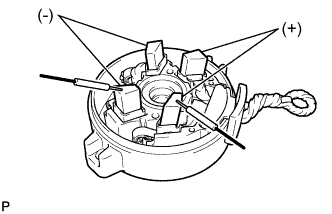 |